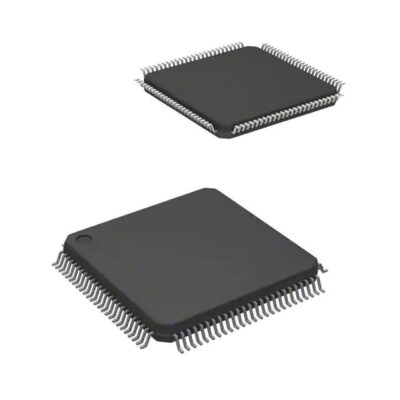STM32F407VET6
Part Number: STM32F407VET6
Manufacturer: STMicroelectronics
Description: IC MCU 32BIT 512KB FLASH 100LQFP
Shipped from: Shenzhen/HK Warehouse
Stock Available: Check with us
ICRFQ.com - Electronic Components Distributor in China Since 2003

Part Number: STM32F407VET6
Manufacturer: STMicroelectronics
Description: IC MCU 32BIT 512KB FLASH 100LQFP
Shipped from: Shenzhen/HK Warehouse
Stock Available: Check with us
| Datasheet | |
|---|---|
| Category | Integrated Circuits (ICs) |
| Family | Embedded – Microcontrollers |
| Manufacturer | STMicroelectronics |
| Series | STM32 F4 |
| Packaging | Tray |
| Part Status | Active |
| Core Processor | ARM? Cortex?-M4 |
| Core Size | 32-Bit |
| Speed | 168MHz |
| Connectivity | CAN, DCMI, EBI/EMI, Ethernet, I2C, IrDA, LIN, SPI, UART/USART, USB OTG |
| Peripherals | Brown-out Detect/Reset, DMA, I2S, LCD, POR, PWM, WDT |
| Number of I/O | 82 |
| Program Memory Size | 512KB (512K x 8) |
| Program Memory Type | FLASH |
| EEPROM Size | – |
| RAM Size | 192K x 8 |
| Voltage – Supply (Vcc/Vdd) | 1.8 V ~ 3.6 V |
| Data Converters | A/D 16x12b, D/A 2x12b |
| Oscillator Type | Internal |
| Operating Temperature | -40°C ~ 85°C (TA) |
| Package / Case | 100-LQFP |
| Supplier Device Package | * |
The STM32F405xx and STM32F407xx microcontroller families feature a high-performance Arm Cortex-M4 32-bit RISC core, operating at up to 168 MHz. With an integrated floating point unit (FPU), DSP instructions, and memory protection unit (MPU), it offers enhanced performance and application security.
These microcontrollers provide ample memory options, including up to 1 megabyte of flash memory and up to 192 megabytes of SRAM. They also offer versatile I/Os and peripherals connected to multiple buses, expanding their capabilities.
With three 12-bit ADCs, two DACs, a low-power RTC, 16-bit and 32-bit timers, and a true random number generator (RNG), these microcontrollers offer a comprehensive range of features. They also include various communication interfaces for connectivity needs.
The STM32F405xx and STM32F407xx microcontroller families deliver high-performance features, versatile memory options, and rich functionality. They empower engineers to develop innovative and efficient solutions for embedded systems, IoT devices, and industrial applications.
The TMP100NA is full of features that make it easy and accurate for engineers and designers to keep track of temperatures. The TMP100NA can be used for many different things because it has a strong core, a lot of memory choices, a wide range of connections, and better analog capabilities.
The Cortex-M4 with FPU is the most up-to-date integrated Arm processor. It was made to meet the needs of MCU implementation with a low number of pins, low power use, high computing power, and better interrupt response at an affordable price. The code-efficient Arm Cortex-M4 32-bit RISC processor with FPU gives Arm core performance in 8-bit and 16-bit memory sizes. DSP instructions make it possible to handle signals quickly and run complicated algorithms. Its single-precision FPU speeds up program development without overloading by using tools for metalanguage development.
The memory accelerator ART Accelerator works well with STM32 Arm® Cortex®-M4 processors with FPU. The FPU gets rid of the need for the CPU to work at lower frequencies while waiting for flash memory. This reduces the performance edge of the Arm Cortex-M4 over flash memory technologies. The speed at which programs run from 128-bit Flash memory is increased by accelerator features like an instruction prefetch queue and a branch cache. At this frequency, the processor can reach its highest speed of 210 DMIPS. The CoreMark benchmark shows that the ART accelerator works as well as running programs straight from flash memory at up to 168 MHz.
The memory protection unit (MPU) controls how the CPU uses memory so that one job doesn’t mess up the memory or resources of another. There can be up to 8 protected places and 8 subareas in this memory space. Protection spaces have between 32 bytes and 4 gigabytes of memory that can be used. The MPU helps protect important or approved code from tasks that have nothing to do with it.
RTOSs handle it. The RTOS can stop programs from accessing memory areas that the MPU doesn’t allow. In RTOS, the kernel can change the setting for the MPU area based on the process. Applications that don’t need the MPU can skip it.
The external interrupt/event driver is made up of 23 edge-detector lines that are used to make requests for interrupts and events. Each line can be set up to choose its own trigger event (a rising edge, a falling edge, or both) and can be covered on its own. The state of the interrupt requests is kept in a register called “pending.” The EXTI can find an external line whose pulse width is shorter than the time of the internal APB2 clock. There are 16 external interrupt lines that can be used to connect up to 140 GPIOs.
In conclusion, the STM32F405xx and STM32F407xx microcontrollers have a wide range of features that engineers and designers can use to meet the needs of different embedded systems. From their powerful cores and large memory choices to their wide range of connections and advanced analog features, these microcontrollers let embedded system development reach its full potential.
Use the STM32F405xx and STM32F407xx microcontrollers in your ideas right now to spur innovation and make sure your projects are a success. Contact ICRFQ to find out what’s possible and get started on the road to developing cutting-edge embedded systems.
WhatsApp us